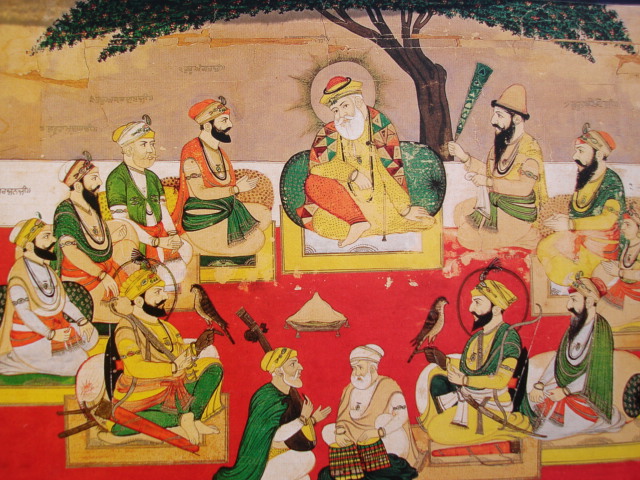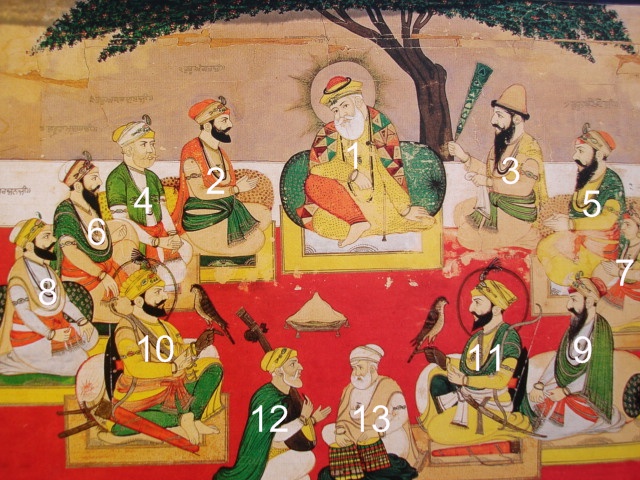Talk:B-40 Janamsakhi
B-40 Janamsakhi
Lucky ji or anyone, do you know if this illustration has any title. It seems as well to include Guru Hargobind ji (left bottom [7 o'clock} two swords (Miri and Piri?) are evident) and another Guru at (4 o'clock) (the third shown with a Halo) who also is noted for having a hawk and bow and arrows.
I go further to guess that it is Bhai Mardana in a topi characteristic of the Muslim Mirasi which is often seen worn by the minstrels in old european art and down through today as a hat associated with 'entertainers/Minstrels'. The musicians at bottom could be Balwand & Satta (when did tablas become common? and the string instrument seems to have a gourd at tuning end of the neck. (a vina or sitar?)
All men are pictured with Karas on their wrists; was this a common practise before Guru Gobind Singh Ji? Allenwalla 02:55, 1 July 2009 (UTC)
Would the person who commissioned this have had himself included in the illustrations?
Another possible explanation
Guru Nanak is pictured with the patchwork coat of a Faqir. Looking closely- names in Gurmukhi are above each of the men.
Though this collection of sakhis is thought to be before Guru Gobind Singh ji. Could the Guru at 4 o'clock be other than he. He too has the quiver, bow, sword, hawk, kalgi and 'Halo'. Surely Guru Tegh Bahadur was never pictured with such symbols?
Can anyone read the names above the portraits?
Wondering if my label added to illustration is correct?
This seems almost as if it is a later "Family Tree of the Sikh Gurus, with Guru Nanak sitting at the root of the tree of Sikhi which covers them all. Leaving out the man doing sewa (fan) and the two musicians there are 10 figures, one a child (Har Krishan?). Though I don't know why some would have no Halos? The labels could answer my questions. thanks for any participation, Raab Rakha.
My guess
Some of the names can be seen written in Gurmukhi in the background but they are not very clear. It may be possible to see them on the original of this photo.
I am not sure about 12 & 13 and Richard may be correct; it may be Balwand and Satta. My guess is:
- 1 is Guru Nanak ji
- 2 is Guru Angad ji
- 3 is Bhai Mardana ji
- 4 is Guru Amar Das ji
- 5 is Guru Har Rai ji
- 6 is Guru Ram Das ji
- 7 is Guru Harkrishan ji
- 8 is Guru Arjan Dev ji
- 9 is Guru Tegh Bahadur ji
- 10 is Guru Hargobind ji
- 11 is Guru Gobind Singh ji
- 12 is Bhai Gurdas ji or Balwand
- 13 is Baba Budha ji or Satta
I am not sure if Kara were worn before Guru Gobind Singh. History of tabla: .... it is thought that the tabla was invented by Amir Khusrau 700 years ago. So the table was around during the times of all the Sikh Gurus. I do not believe that in the eastern art world it was common to include the printer in the picture.
Another possiblity
- 1 is Guru Nanak ji
- 2 is Guru Angad ji
- 3 is the painter
- 4 is Guru Amar Das ji
- 5 is Guru Har Rai ji
- 6 is Guru Ram Das ji
- 7 is Guru Harkrishan ji
- 8 is Guru Arjan Dev ji
- 9 is Guru Tegh Bahadur ji
- 10 is Guru Hargobind ji
- 11 is Guru Gobind Singh ji
- 12 is Bhai Mardana ji
- 13 is Bhai Bala ji
Hari Singhtalk 00:11, 2 July 2009 (UTC)
Either way
Thanks , either way works, my thought that this was a portrayal of all ten Gurus and that Guru Gobind Sing was in the painting, which would either mean that the page was added later to the book or it was published after Guru Gobind Singh had become an adult or that the illustration belongs elsewhere?
Interesting that both Guru Arjan Dev and Guru Tegh Bahadur, both noted as men of peace, who both were Martyred, are pictured clothed in white along with Guru Amar Das who came to be Guru at an elderly age.
- As to why there are no Halos on most of the Gurus, I think that only Guru Nanak was portrayed with one originally. The Halos around the two Gurus who raised armies against oppressors, I would guess, were added by some young admirer, probably a child, who had access to the book, a child who was not a Sikh (a child of an English soldier or statesman who may have been told stories of the bravery of the Sikhs, one who like most children admire warriors and one who had a black pen). A child who was not taught to respect a book as children of Sikhs, Hindus and most Asians are. I think that probably the decendants of whomever carried this Janamsaki to England, eventually realized the book was valuable and either sold or gave the book away to the India Office Library in London.
I say this because I don't think that a thick black line would have been used by the artist and because the halos are drawn right over the Kalgis (not stopping either side of them) and are not even good circles--the halo around Guru Gobind Sing ji is crudely drawn-- the object used to trace around Guru Gobind Singh was not exactly circular. Allenwalla 16:50, 2 July 2009 (UTC)


